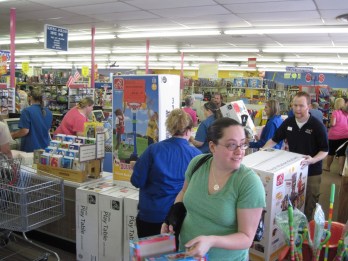Teddy Roosevelt said, “Whenever you are asked if you can do a job, tell ’em, ‘Certainly I can!’ Then get busy and find out how to do it.”
On the other hand, Steve Jobs said, “It’s only by saying ‘No’ that you can concentrate on the things that are really important.”

Teddy wants you to take on any job you can. Steve wants you to only take on the important jobs.
Who is right?
Teddy is right when it comes to serving your customers. If a customer asks if you can do something for them that you have never done, you should seriously consider doing it. First, if the customer is asking, the customer must believe it is something you can do. Second, it meets and/or exceeds their expectations, which is the hallmark of WOW Customer Service. Third, it might just become the new calling card you need to set yourself apart from your competitors.
You should always be looking for new ways to take care of your customers.
Steve is right when it comes to advertising. It is easy to “dabble” in advertising, doing a little here and a little there, clinging to the false hope that the more different things you do, the more people you will reach to drive into your store. We mistakenly believe that advertising is simply a numbers game and the more people we reach, the more traffic we’ll get. Yes, it is a numbers game, but not all numbers are equal.
Roy H. Williams often asks the question, “Would you rather convince 100% of the people 10% of the way or 10% of the people 100% of the way? In advertising, both cost the same.” The goal of your advertising is to convince people to visit your store and shop with you. You don’t convince people if all you do is “dabble”. You simply annoy them. It takes time, frequency, and focus to convince the people you reach to finally decide to shop with you. You have to pick and choose your media carefully and then be in full in with that media. If you aren’t, you are wasting your ad budget.
Both are right when it comes to inventory. You need to follow Steve’s advice and make sure you first stock your store with the most important items. When cash flow is tight, focus on the must-haves. Focus on the items that customers come in asking for by name. Make sure you have plenty of the requested items and you’ll make the sales you need to keep the cash flowing. You also need to keep looking for new products and new opportunities. Unless you’re strictly in the commodities business, customers want to see what is new and fresh. If you don’t have new and fresh, you are boring your customers and eventually they won’t bother coming back.
After the must-haves, the second most important inventory spending should be on the brand-new. It keeps your store fresh, keeps your staff energized, keeps your customers returning.
Sometimes you have to follow President Roosevelt. Sometimes you have to follow Mr. Jobs. Knowing when to say Yes and when to say No is the key to your success.
Perhaps Neils Bohr said it best when he said, “The opposite of a correct statement is a false statement. But the opposite of a profound truth may well be another profound truth.”
-Phil Wrzesinski
www.PhilsForum.com
PS I used both quotes in presentations lately and it struck me how profound, yet at odds, they both seem to be. I also have found myself using both quotes in my own life. I have been asked to do a lot of new things lately. I have said Yes to creating several new presentations, different from the homerun talks I do. I’ve also said No to some opportunities because they didn’t push forward my main industries of speaking, writing, and consulting. I think knowing when to say No is truly an art, one in which I am still the amateur, but I am learning. How about you?





 I know the feelings of this week. I lived it for twenty three years, and lived with it for another twenty seven. The slowdown from the busy weekend gives you too much time to think about what you might have done differently, what you haven’t done, and what you’re afraid might happen.
I know the feelings of this week. I lived it for twenty three years, and lived with it for another twenty seven. The slowdown from the busy weekend gives you too much time to think about what you might have done differently, what you haven’t done, and what you’re afraid might happen.
 First, after going back and adjusting my market size for economy and youth population, our 12% was really closer to 16%. It stayed in that neighborhood until a Walmart Supercenter opened in 2005. We dropped into the 14-15% neighborhood and stayed there until Amazon became a serious player in the toy industry around 2010-2011. We stayed around 12.5% for the next several years until we closed. Even though you can
First, after going back and adjusting my market size for economy and youth population, our 12% was really closer to 16%. It stayed in that neighborhood until a Walmart Supercenter opened in 2005. We dropped into the 14-15% neighborhood and stayed there until Amazon became a serious player in the toy industry around 2010-2011. We stayed around 12.5% for the next several years until we closed. Even though you can  It’s all the same thing.
It’s all the same thing.